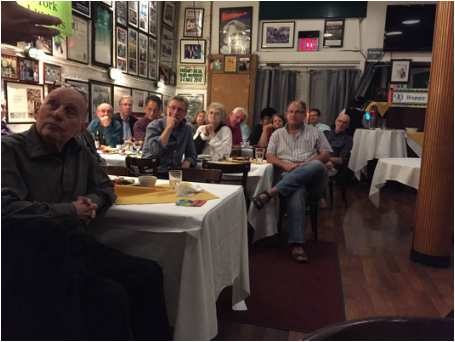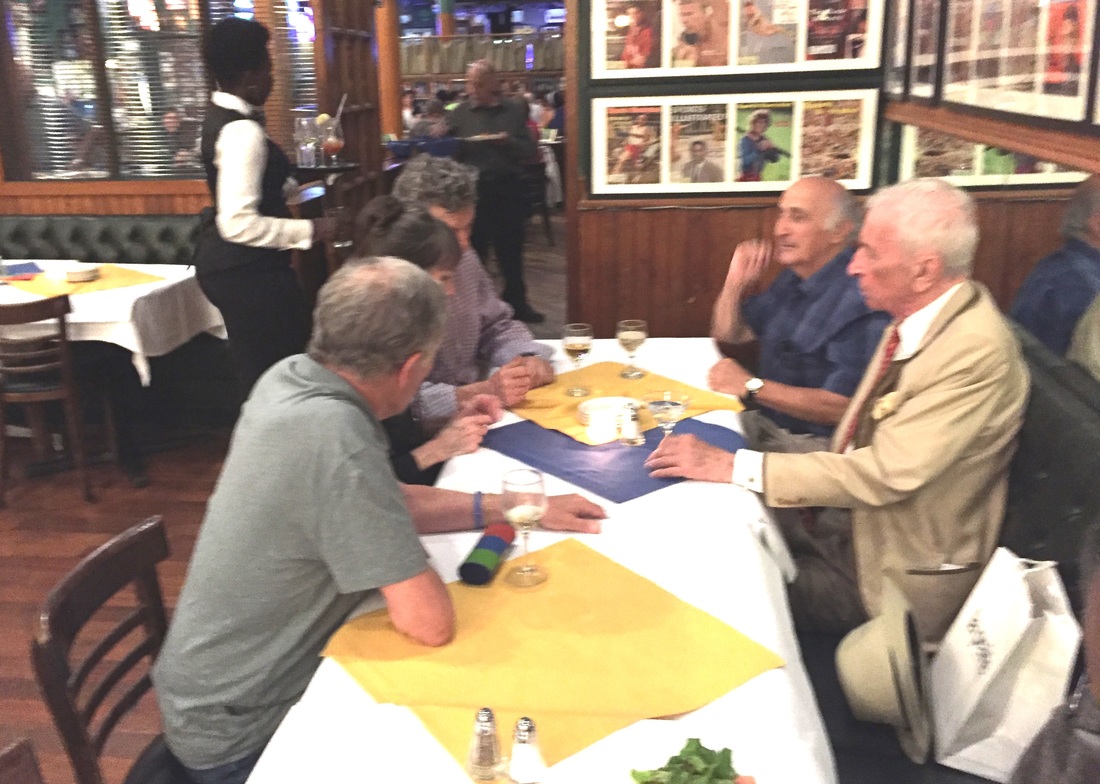|
On his theory that it is not every day that a person turns 90, Frank Litsky threw himself a party the other night.
Frank drew over 40 old hands from the Times, who celebrated him – and our business, which was putting out the paper on deadline. Looking great, sounding great, Frank noted others in his nonagenarian state – Tony Bennett, Fidel Castro, Queen Elizabeth II and Prince Philip, Cloris Leachman, Jerry Lewis, Mel Brooks, Don Rickles, just to name a few. (The overall list is impressive.) Colleagues from the 50’s and 60’s, Gay Talese and Bob Lipsyte, made lovely talks about Frank’s energy and knowledge and productivity. In an informal chat, I reminded Frank of my nickname for him -- Four-Fifty. This stems from when I came over from Newsday in 1968 with a lot to say, and Frank was the day assignment editor who shoehorned stories into the section. I would check in each day with proposals for lengthy rambles about the Amazing Mets or the post-Mantle Yankees, and Frank would cut me dead with the fatal words: “Four-fifty.” That is, 450 words Frank Litsky stifled my imagination and made it impossible to show my stuff, to the point that my career and the paper suffered terribly. He has never repented. We crowded into Coogan’s Restaurant in Washington Heights, near the armory which has been refurbished to house Frank’s beloved track and field. (The proprietor, Peter Walsh, himself a copy boy at the Times in the late ‘60’s, even serenaded us with a song in Gaelic.) We all had histories with each other, over the decades: Sports editors who had made tough decisions. Copy editors who had pulled stories together minutes before the press run. Reporters who had broken good stories. Columnists who had typed our precious little thoughts. Clerks and office managers who made the whole thing work. Margaret Roach, the journalist daughter of James Roach, the beloved sports editor of the ’60’s, was there. Joe Vecchione and Neil Amdur, two subsequent sports editors. Fern Turkowitz and now TerriAnn Glynn, who held the section together. All of us could, if we tried, recall snit fits and frustrations with some of the people we were now hugging. But what we remembered most was somehow letting the esteemed production people push the button on time. What we had in common was the identification with the physical product that people held in their hands, read seriously. It is in our blood. Frank Litsky, who covered Olympics and pro football and women’s basketball, has known good times and terrible times, and now he sat there, a wise old Buddha figure with a New York accent, with “the love of my life,” Zina Greene, listening to old stories, some true. One thing I learned that night was that in his alleged retirement, Frank has contributed over 100 obituaries of sports figures, sitting there in the digital can. I am betting all his masterpieces go over 450 words. Just saying.
Altenir Silva
9/24/2016 01:25:33 pm
Dear George,
George Vecsey
9/24/2016 03:10:18 pm
Dear Altenir: Thanks for the links about Bibi Ferreira, another nonagenarian.
Kathleen McElroy
9/24/2016 03:40:34 pm
What a lovely evening for a wonderful person. Just being Frank taught me a lot about journalism, hard work, hustle and yes, being a good guy.
George Vecsey
9/24/2016 05:18:31 pm
Dear Dr. McElroy: You also learned to think second career. Enjoy Austin. G
Mike from Whitestone
9/24/2016 11:36:34 pm
Thanks GV.
Brian Savin
9/25/2016 08:51:57 am
The only thing that kept the floor from breaking from the weight of the IQ’s in that room was probably the levitating effect of GV's levity.
George Vecsey
9/27/2016 12:03:35 pm
Brian, thanks for the faith in us.
Brian Savin
9/27/2016 01:02:13 pm
p.s. A beef pie is properly a "cottage" pie. Never been to Foley's, mostly 'cause the world's best "mutton chop" is three blocks away......(but requires a willing and hungry partner to share the dear animal).
bruce
9/26/2016 11:02:21 am
George,
George Vecsey
9/27/2016 12:06:48 pm
Bruce, thanks.
bruce
9/27/2016 02:58:48 pm
George,
George Vecsey
9/27/2016 06:22:51 pm
Bruce, I can't really grump about older voices because the NYT has a lot of 50-60-=70 types who know New York and their subjects...I look forward to their bylines. And there is so much younger talent. Plus, the investigative reporting in sports is the best it's ever been (Rebecca Ruiz)....Other papers have had much worse massacres of talent and experience. GV
bruce
9/27/2016 06:41:22 pm
George,
Brian Savin
9/27/2016 06:55:59 pm
Bruce, I agree with you. George is my idol because of his intelligent writing, interest in teaching readers, and a moral. courage that he wears on his sleeve for all to see. However, I observe a change at the Times that elevates editorial interference over journalistic integrity to an unwarranted degree that even has caught the attention of the Times Public Editor. The Times isn't the Times of the people who gathered at Coogans. I hope that paper returns.
bruce
9/27/2016 07:26:27 pm
brian,
George Vecsey
9/28/2016 12:24:51 pm
Bruce and Brian, thanks for the nice words.
bruce
9/28/2016 01:17:16 pm
George, 9/30/2016 03:26:41 pm
Enjoyed every bit of your blog.Really looking forward to read more. Cool. 10/2/2016 05:37:54 pm
Your great piece on Frank Litsky brought back many fond memories. I always enjoyed his work.
bruce
10/2/2016 05:56:56 pm
alan, 10/3/2016 10:07:51 am
The area between 150-178th streets, especially east of Broadway, were considered to be dangerous with many gangs. It was also ethically different from above 181st street.
bruce
10/3/2016 10:24:37 am
alan,
Brian Savin
10/2/2016 07:08:53 pm
I liked your post, Alain. I'm glad the Eagle has found a financial home. They care about community and neighbors.
George Vecsey
10/3/2016 04:35:14 pm
Definitely good news. So many bad owners. When I was a news reporter I would encounter the Eagle. Plus, best weekly in Kentucky was the Mountain Eagle. It respected miners and screamed at what the coal industry was doing. Comments are closed.
|
Categories
All
|











